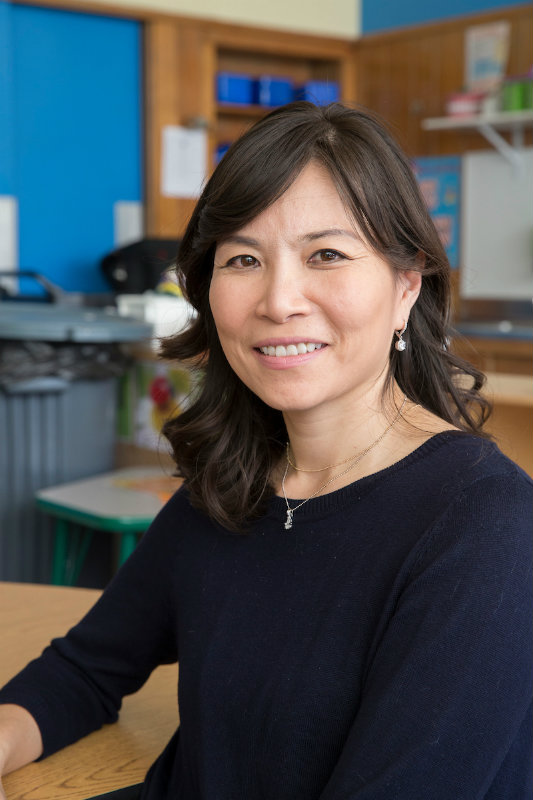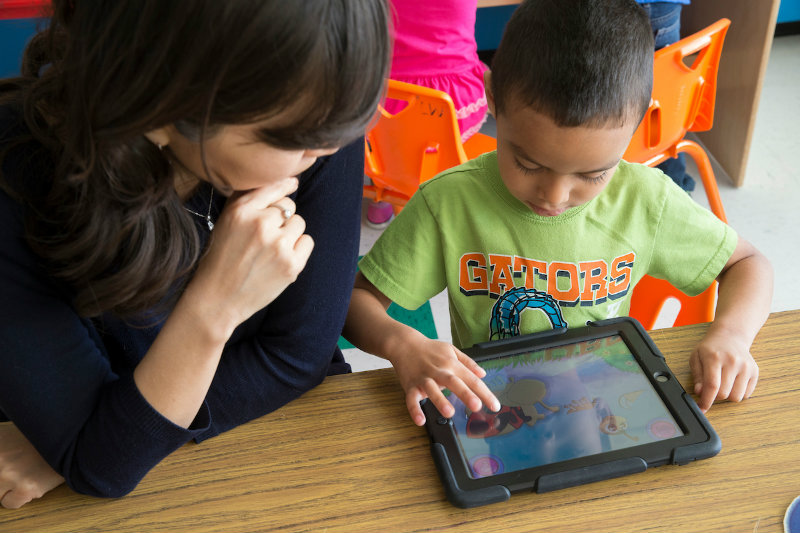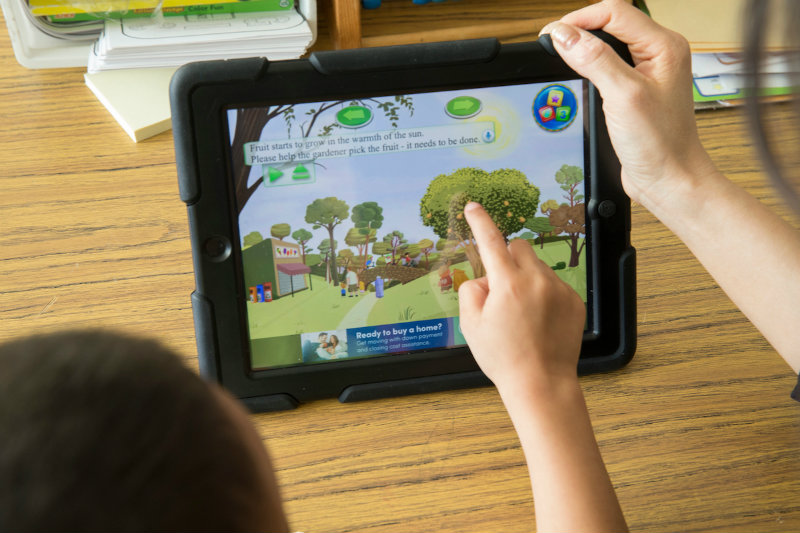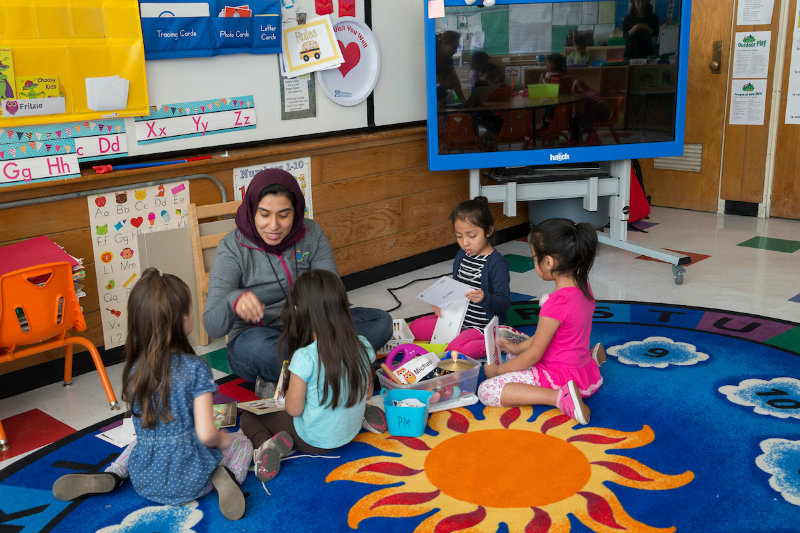Why Disadvantaged Children Struggle in School and How to Help Them Succeed

James M. Loy, Miami University's College of Education, Health, and Society
As a team member of the Low Income Preschool Enhancement Project, Jaclyn Caballero had been using an educational iPad app to teach young children where rain goes after it falls from the sky. Suddenly, the concept finally “clicked.”
“I had a student who didn’t quite understand the water cycle, which is a very difficult concept for preschoolers,” say Caballero, a Miami University transformative education graduate student. “But later, when it started to rain more. This child turned a whole new page about what it means for the water to fall and then for it to evaporate, and go up into the clouds. It really impacted them within a very short number of weeks.”
During the development of most young children, there are moments when ideas fall into place and new connections are made, when they begin to associate abstract concepts with an understanding of the world and their place within it.
This should be a natural part of the educational process for most children. However, there are still a number of cultural forces and social contexts that can inhibit this development for certain demographic groups. This is especially true for children coming from low socioeconomic status (SES) or from non-native English-language learning families (ELL), or both.
Many of these children face a variety of inequalities and barriers. Some exist on the wrong side of the digital divide, or they lack support and encouragement or the cultural skills needed to thrive in classrooms mostly dominated by white middle and upper class values, or even all of the above.
These are the groups of children that Caballero is striving to help, and her ongoing work on culture, diversity, and ways to decrease the student achievement gap is what led her to Dr. Lena Lee, the principal architect and primary researcher of the Low Income Preschool Enhancement Project (LIPE).
A Miami University associate professor in the College of Education, Health and Society (EHS), Lee uses LIPE to help marginalized children from diverse backgrounds succeed in school.
And since 2014, the project has received funding from the PNC Foundation, a non-profit organization that promotes the growth of underserved children and communities through progressive initiatives.
“The foundation was interested in how to effectively support young children with technology, and to prove if it is really working or not,” says Lee. “They were also interested in supporting low income children’s experiential learning. So I wanted to support not only academic content, but their general experiences, discourses, and dialogues that occur in everyday life as well.”
LIPE, therefore, combines digital technology with one-on-one interactions and experiential learning to give young low-SES and ELL children the foundational knowledge and the cultural capital they will need to stay in step with the evolving demands of a contemporary educational climate.
 Education may not be a race, but it can feel like one for those constantly struggling to gain lost ground. And today, many disadvantaged students, and their families, will often find themselves outpaced by an educational system that habitually requires technological, linguistic, and academic proficiencies beyond their reach and social expectations outside their cultural purview. And as these cultural, digital, and socioeconomic gaps continue to widen, some children will inevitably fall behind before they even begin.
Education may not be a race, but it can feel like one for those constantly struggling to gain lost ground. And today, many disadvantaged students, and their families, will often find themselves outpaced by an educational system that habitually requires technological, linguistic, and academic proficiencies beyond their reach and social expectations outside their cultural purview. And as these cultural, digital, and socioeconomic gaps continue to widen, some children will inevitably fall behind before they even begin.
“Many young children coming from low income families are behind even when they get to kindergarten,” says Lee. “Then, if they are already behind in kindergarten, there is no easy way for them to catch up. Many Latino and African American children drop off, particularly during high school. But that does not all of a sudden happen. That has been built since they were born because the early care and education of their first five years was missing. There is a strong correlation between the early learning and the rest of their life path.”
But this, unfortunately, is a fate that many low socioeconomic, ELL, and ethnic minority students still endure. But, through early intervention, preparation, personalized engagement, and community support, it’s also a fate that LIPE hopes to help children ultimately avoid.
And according to new research published in Computers in the Schools, the project is already off to a strong start. Lee, along with Xintian Tu, a Miami graduate student studying educational technology and assessment, have found statistically significant improvements in achievement scores for almost all participating children.
Closing the Digital Divide, Building Cultural Capital
LIPE currently operates in four separate Head Start and preschool programs located throughout Hamilton, Ohio. In total, these programs support 12 different classrooms, each consisting of between 15 to 20 children aged three to five years old (180 to 300 children per year). To manage the classrooms, Lee recruits approximately a dozen or so EHS graduate and undergraduate students, most of whom are studying to become educational professionals themselves.
In the fall, the team focuses on math-related concepts. In the spring they switch to science. And twice weekly, they each visit their respective classrooms to work individually with the children, lead group projects, and combine hands-on learning with digital devices such as iPad-based learning apps that connect educational technology to real life experiences.
“Every week is scheduled with different activities,” says Nicole Schlimm, a Miami undergraduate and early childhood education major. “We started with teaching them about the five senses and we did a pretest to see where they were. We had an iPad app that walked them through the five senses, and I also did an entire class lesson that brought in different things that they could touch or smell or see, to give them more practice.”
Another lesson used an interactive app that, in fast motion, showed how plants grow. Then, each child received and painted their own pot, and planted real seeds to grow. Other lessons involved math and counting, social studies and community engagement, and more. Each exercise was specifically designed to connect digital engagement with the physical world, and the lessons were further augmented by occasional guest speakers, family science fair night with the Cincinnati Museum, and an end-of-the-year field trip.
Throughout this entire process, the goal is to achieve at least three primary objectives -- the first of which is closing the digital divide.
Not long ago, gaps in technology meant a stark and objectively definable line between the “haves” and the “have-nots.” And while in some instances, this may still be the case, the current ubiquity of digital technology means that this is now less so. Most families, regardless of financial resources, either have or have access to some form of digital technology.
There are, however, growing disparities in the ways these different households actually use such devices.
“A low income family’s child might have technology, but they are not usually using it for their education,” Lee says. “That is completely different from how middle and upper class parents are adapting to technology. A low income family’s use is more for entertainment or for babysitting young children. Middle and upper class parents also do this, but many of them use it for education and learning as well. The difference between the two groups is not if there is technology use, but rather it is how much time and who get involved, as well as the children’s type of exposure to technology. They are in completely different worlds, even if they do use the same iPad or computer.”
And as digital engagement continues to rise in prominence and occurrence, the adoption of such devices in classrooms is becoming more widespread, which subsequently results in low income children who are far less prepared than their more affluent counterparts to effectively reap the benefits. LIPE, of course, addresses this problem by showing low income children how apps and games can be directly applied to school.
Another benefit of LIPE centers squarely on the actual relationships these activities build with the college students themselves, who help instill and nurture the cultural capital that is also crucial for these children to gain. Much of Lee’s LIPE research has involved Latino children, and she has witnessed the incongruities between their cultural values and those they face as part of the educational system’s status quo.
“Middle and upper class white families tend to think education should be focused on content learning and skills, but the educational concept of Latino families is a little bit different,” Lee explains. “Their concept of education starts with relationships. So they need to build the relationship first and then build that content learning within. But the American school system does not really reflect these different cultural backgrounds and values well.”
Middle class families are far more likely to introduce concepts like counting, reading, and writing to their children very early on. They are more likely to talk about such things over the dinner table, read books at bedtime, visit science museums on the weekend, and so on. And since these are also the same dominate values present in the school system -- one that prioritizes a presumed familiarity with basic concepts over social relationships -- many Latino children from low income families are, once again, forced to play catchup before they even begin.
LIPE’s second objective, therefore, is to counteract these effects, and to do so it builds on the Vygotskian social development theory known as the “More Knowledgeable Other,” which posits that cognitive child development depends on the presence of a supportive and encouraging learning environment. Here, the college students fill that role through the interpersonal discourses, the inquiry-based interactions, and the individual attention they afford each child.
And, finally, this is exactly how the process also benefits the college students themselves. Through LIPE, they gain the first-hand experience that many will need while working toward careers as early education professionals.
“You can only learn so much from sitting in a classroom, but interacting with the kids you get to see what you’re learning actually being played out,” says Schlimm. “Even just seeing the classroom structure, like how a teacher organizes her classroom, how she manages the kids, different activities that she does with them. I don’t think I could get this experience anywhere else, especially working with technology and getting to do class instruction.”
Research and Results
Much of Lee’s current research revolves around LIPE, and she routinely brings her students into this process as well.
To determine their progress, each child is administered a pretest and a post-test. Additional assessments also include teacher interviews, Miami student evaluations, and soon direct feedback from the families will also be incorporated. Both undergraduates and graduate students help collect the data. And afterwards, they frequently present their personal findings based on their experiences at various conferences and even publish papers.
“I got to see [the research] one-on-one, and it was amazing to see those numbers and they almost all grow,” says Cabellero. “It is great to know that they are learning in their classrooms with our help.”
Caballero’s involvement lead to a co-authored conference paper with another EHS graduate student titled, “There's an App for That: Preschoolers Benefit from iPad Usage,” which she recently presented at the National Association of Early Childhood Teacher Educators conference in Los Angles. Several other Miami students have also presented at various local and regional conferences such as the Miami Undergraduate Research Forum and the Ohio Association of Young Children (OAEYC).
Lee’s own research also utilizes the findings of LIPE, which has informed several reports and case studies. In addition to the aforementioned work appearing in Computers in the Schools, as well as several additional national and international conference presentations, Lee and Tu have also recently published in the International Journal of Early Childhood Learning.
Together, their work has shown the quantifiable correlation between the use of digital technology in early childhood educational settings and achievement performances in both ELL and low income students.
Going forward, the door is now open for even more innovative pedagogical techniques, those that combine experiential learning with continually emerging technological resources, to help all children succeed, especially anyone who may find themselves a little bit behind.
“It has been really meaningful to see the kids’ progress,” says Charisse Junk, an early childhood education major and current LIPE team member. “We do a lot of assessing, and by the end of the semester they know so much. You can really tell you’ve helped these children.”

